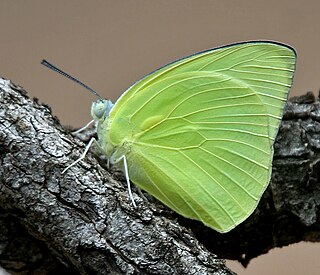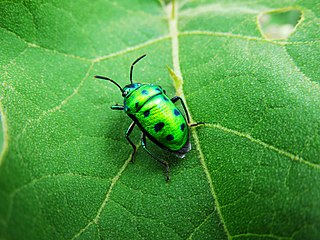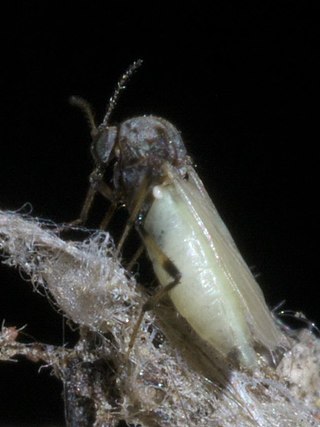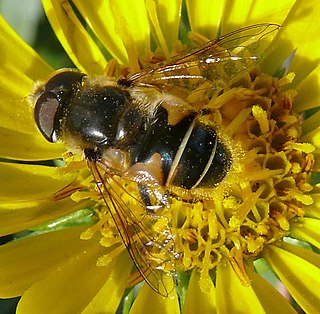
The Pentatomoidea are a superfamily of insects in the suborder Heteroptera of the order Hemiptera. As hemipterans, they possess a common arrangement of sucking mouthparts. The roughly 7000 species under Pentatomoidea are divided into 21 families. Among these are the stink bugs and shield bugs, jewel bugs, giant shield bugs, and burrower bugs.

Scutelleridae is a family of true bugs. They are commonly known as jewel bugs or metallic shield bugs due to their often brilliant coloration. With the name based on the Asian genus Scutellera, they are also known as shield-backed bugs due to the enlargement of the thoracic scutellum into a continuous shield over the abdomen and wings. This latter characteristic distinguishes them from most other families within Heteroptera, and may lead to misidentification as a beetle rather than a bug. These insects feed on plant juices from a variety of different species, including some commercial crops. Closely related to stink bugs, they may also produce an offensive odour when disturbed. There are around 450 species worldwide.
The arthropod leg is a form of jointed appendage of arthropods, usually used for walking. Many of the terms used for arthropod leg segments are of Latin origin, and may be confused with terms for bones: coxa, trochanter, femur, tibia, tarsus, ischium, metatarsus, carpus, dactylus, patella.

Catopsilia pomona, the common emigrant or lemon emigrant, is a medium-sized pierid butterfly found in Asia and parts of Australia. The species gets its name from its habit of migration. Some early authors considered them as two distinct species Catopsilia crocale and Catopsilia pomona.

This glossary of entomology describes terms used in the formal study of insect species by entomologists.

The Agromyzidae are a family of flies, commonly referred to as the leaf-miner flies for the feeding habits of their larvae, most of which are leaf miners on various plants. It includes roughly 2,500 species, they are small, some with wing length of 1 mm. The maximum size is 6.5 mm. Most species are in the range of 2 to 3 mm.

Rhaphigaster nebulosa, common name mottled shieldbug, is a species of stink bug in the family Pentatomidae.

Calliphara nobilis is a species of jewel bug found in Asia. Like all species of jewel bugs, it is phytophagous, feeding on the leaves, fruit and seeds of its host plants. This insect is notable for its multiple defense mechanisms: it is highly mobile and swarms disperse with a loud buzz when disturbed; it is aposematically colored, which serves as a warning to any would-be predators that it is unpalatable; and it possesses a robust chemical defense mechanism: it can secrete an irritating and toxic fluid from a pair of metathoracic scent glands when threatened.

Chrysocoris stollii is a polyphagous species of jewel bugs (Scutelleridae) common in continental Southeast Asia.

Bezzia nobilis is a species of biting midges in the family Ceratopogonidae. It is widely considered one of the most common Bezzia species; it is found in Eurasian regions, all over the United States, Central America, and even into South American countries like Brazil. B. nobilis seem to prefer aquatic environments; they are commonly observed in stagnant water pools in Eurasia regions and marshes in the southern United States. Adults of this species are easily distinguished by their black and yellow striped legs. Pupae are recognized by their brown bodies, abdominal spines, and respiratory horns. B. nobilis larvae are distinguished by brown heads and white bodies. Little information is known on their life cycle or mating habits. B. nobilis is a predatory species. While some research suggests they mainly feed on larvae of other insect species, experiments suggest they prefer immobile, easy prey such as dead adult flies, bacteria, and protozoa.

Blera humeralis, the yellow-legged wood fly, is an uncommon species of syrphid fly officially described by Samuel Wendell Williston in 1882. Hoverflies are so-named for the ability to remain nearly motionless while in flight. The adults are known as flower flies, as they are commonly found around and on flowers from which they get energy-giving nectar and protein-rich pollen. The larvae are of the rat-tailed type, feeding on exuding sap or in the rot holes of trees.

Eristalis hirta, the black-footed drone fly, is a common Western North American species of syrphid fly, first officially described by Loew in 1866. Hoverflies get their names from the ability to remain nearly motionless while in flight. The adults are also known as flower flies as they are commonly found on and around flowers, from which they get both energy-giving nectar and protein-rich pollen. The larvae are aquatic filter-feeders of the rat-tailed type.

Harmonia octomaculata is a species of ladybird of the family Coccinellidae. It is found throughout India, Pakistan, Nepal, Bangladesh, Sri Lanka, Micronesia, and Australia.

Chrysocoris pulchellus is a jewel bug in the family Scutelleridae.
Hybosorus orientalis, is a species of scavenger scarab beetle found in Nepal, Pakistan, India, Sri Lanka, Afghanistan, Myanmar, Sumatra, and Java.

Eumorphus quadriguttatus, the four spotted handsome fungus beetle, is a species of handsome fungus beetle found in India, Andaman Islands, Sri Lanka and Korea.
Reddyanus ceylonensis is a species of scorpion in the family Buthidae endemic to Sri Lanka.
Jauravia limbata, is a species of lady beetle native to India, Sri Lanka, Nepal and Bhutan.

Chrysotoxum grandis is a hoverfly species found in Japan.

Trachyaretaon negrosanon is a stick insect species from the family Heteropterygidae native to Negros.
















